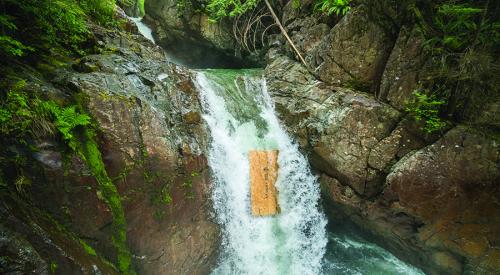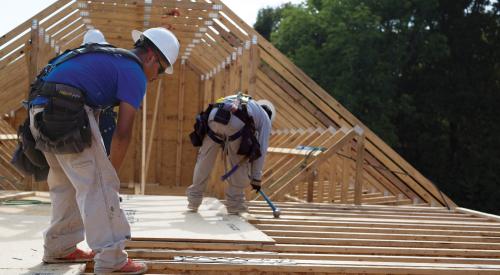After a 14-month, four-phase testing, the University of Maine has released its conclusions that LP Legacy OSB subflooring panels see no degradation of performance in a variety of adverse conditions.
“Typical tests for OSB look at strength and stiffness; they’re usually really quick and can be done in a lab in an hour. But none truly emulate the conditions you’re going to see in the real world,” says Brian St. German, director of technology at LP. “What we’re trying to do with this testing is to show builders that this high-performance OSB panel will actually perform better.”
As part of the effort to confirm the specs of its OSB subfloor, the company partnered with the University of Maine Advanced Structures and Composites Center, “where wood scientists tested LP Legacy panels alongside commodity OSB and plywood in a four-phase, 14-month study designed to simulate the potential extremes of a real jobsite and wear in a finished home,” the company says.
The study consisted of four phases:
Fastener holding capacity tested by creating small-scale floors of oak hardwood flooring stapled to the sub-floor and pulled off with a specially designed test jig. LP Legacy offered a 35% higher withdrawal capacity compared to the other two subjects.
Testers subjected the panels to a simulated rainstorm for eight hours, brought the panels back down to their original moisture content for 48 hours, and then repeated the process two more times. LP Legacy took two and a half times longer to absorb the moisture compared to the other two products, and once again had the highest fastener holding capacity.
For Phase 3, testers simulated seasonal moisture variations that exist in most homes by taking the samples from the Phase 2 wetting cycle, attaching hardwood flooring, and cycling between moisture extremes in a conditioning chamber. After nearly a year, the LP Legacy sub-flooring panels had no significant dimensional changes.
Finally, the panels underwent a 50,000-step-load simulation. Testers looked for floor squeaks, as well as the withdrawal capacity of fasteners after all of the exposures. After four phases of testing, LP Legacy showed no reduction in fastener capacity.
[ Related: LP Legacy - University of Maine Product Testing #2 ]
“After all of the exposures, the repeated wetting, the repeated hydrothermal cycling, and the repeated loading, the fastener capacity of Legacy OSB has virtually remained unchanged,” Benjamin Herzog, a wood technologist for University of Maine who was conducting the tests, says in a statement.
LP says these tests from the university add to those the company has conducted over the past several years to push LP Legacy to the extremes to help prove its worth under jobsite condition. The company also included the Tested Extreme campaign, in which LP sent panels sent over a waterfall, converted them into muddy mountain bike ramps, and submerged them as a shark cage.
“What we’ve seen is there is no degradation of performance,” says St. Germain of the latest round of tests. “After final testing, we saw the same level of performance that we did prior to cycling.”
LP says claims its Legacy sub-flooring is among the strongest in its class and the industry’s stiffest panel. Made with Gorilla Glue, the panels are stiff, making them ideal for hardwood flooring and tile applications, and their high density provides exceptional fastener holding strength and a quieter floor, the company says.











